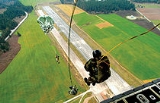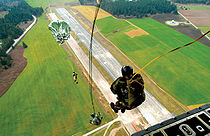
Static line
Encyclopedia


Workplace safety
Workplace safety & health is a category of management responsibility in places of employment.To ensure the safety and health of workers, managers establish a focus on safety that can include elements such as:* management leadership and commitment...
and
to open parachutes automatically for paratroopers and novice parachutists
Parachuting
Parachuting, also known as skydiving, is the action of exiting an aircraft and returning to earth with the aid of a parachute. It may or may not involve a certain amount of free-fall, a time during which the parachute has not been deployed and the body gradually accelerates to terminal...
.
Use in parachuting
In parachuting, a static line is a cord attached at one end to the aircraft and at the other end to the top of the pilot chutePilot chute
A pilot chute is a small auxiliary parachute used to deploy the main or reserve parachute. The pilot chute is connected to the deployment bag containing the parachute by a bridle. On modern skydiving rigs three types of pilot chutes can be found:...
inside the jumper's backpack. The parachutist's fall from the aircraft causes the static line to become taut, then it pulls the pilot chute free of the backpack. The inflation of the small pilot chute in turn causes the main canopy to be pulled out of the backpack. The continued fall of the jumper causes the main parachute lines to extend and become taut, at which point the binding that joins the static line to the pilot chute comes apart from the shock of the jumper's weight, freeing the parachute and its passenger to continue descending freely, no longer connected to the aircraft. The main parachute then inflates, braking the fall. This static line mechanism opens the parachute automatically with no action required by the passenger.
The parachutist must adopt and maintain a suitable body position throughout deployment to minimise the chances of a parachute malfunction. This method of parachute deployment is commonly used in several ways:
- Training student skydivers
- BASE jumpingBASE jumpingBASE jumping, also sometimes written as B.A.S.E jumping, is an activity that employs an initially packed parachute to jump from fixed objects...
- Military paratrooperParatrooperParatroopers are soldiers trained in parachuting and generally operate as part of an airborne force.Paratroopers are used for tactical advantage as they can be inserted into the battlefield from the air, thereby allowing them to be positioned in areas not accessible by land...
s jumping from very low altitudes (400+ feet or 122+ meters) - Soviet and successor state military standard procedure for all airborne infantry jumps, regardless of altitude
Static line jumping carries risk of injury that, according to one study, doubles when performed in combat.
For training students in civilian operations, modifications to existing static line equipment may be made to simplify operations. One such modification is to attach the deployment bag to the parachute instead of the static line, which also requires some modification to allow the static line to detach, typically a Velcro
Velcro
Velcro is the brand name of the first commercially marketed fabric hook-and-loop fastener, invented in 1948 by the Swiss electrical engineer George de Mestral...
fastener. This leaves much less material "in the wind" behind the plane after the jumper has left; this isn't a problem for larger cargo aircraft
Cargo aircraft
A cargo aircraft is a fixed-wing aircraft designed or converted for the carriage of goods, rather than passengers. They are usually devoid of passenger amenities, and generally feature one or more large doors for the loading and unloading of cargo...
used in military jumping, but presents a major issue for smaller aircraft used in civilian operations. This modification also results in a somewhat slower opening, which softens the opening shock at the cost of altitude, a minor concern for jumpers exiting at 2800 ft (853.4 m).
Use in construction
In construction, a static line is a safety measure consisting of a cable race fixed to a roofRoof
A roof is the covering on the uppermost part of a building. A roof protects the building and its contents from the effects of weather. Structures that require roofs range from a letter box to a cathedral or stadium, dwellings being the most numerous....
at intervals to which a safety harness
Safety harness
A safety harness is a form of protective equipment designed to protect a person, animal, or object from injury or damage. The harness is an attachment between a stationary and non-stationary object and is usually fabricated from rope, cable or webbing and locking hardware...
may be tethered.
External links
- What is Static Line Training? from DZsocial.com
- Static Line Monthly publication since 1947 for, by and about paratroopers, glidertroopers, air assault troopers.
- ArmyParatrooper.org Unofficial headquarters of military Paratroopers, past and present.
- The European Military Parachuting Association

